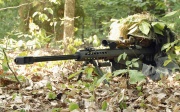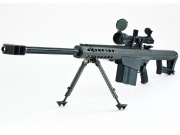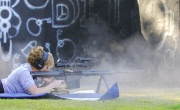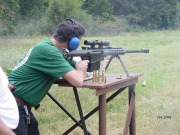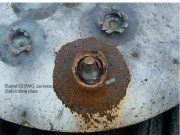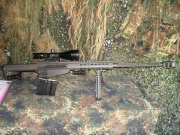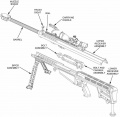Barrett M82
| M82 / M107 | |
|---|---|

| |
| The Barrett M82A1 with AN/PVS-10 day/night optic. | |
|
| |
| Type | Anti-materiel rifle |
| Land of Origin | USA |
| Specifications | |
| Length | 1,450 mm (57.1 in) (M82A1) |
| Barrel length | 508 mm (20.0 in) 733 mm (28.9 in) |
| Weight | 13.6 kg (29.98 lb) (M82A1) |
| Cartridge | .50 BMG (12.7x99mm NATO |
| Action | Recoil operated, rotating bolt |
|
| |
| Muzzle velocity | 853 m/s (2,799 ft/s) |
| Effective Range | 1,850 m |
| Max. Range | 6,800 m |
| Feed | 10-round detachable box magazine |
| Sights | Fixed front, adjustable rear sight; MIL-STD-1913 rail provided for optics |
| Service History | |
| In service | 1989–present |
| Used by | See Users |
| Production History | |
| Designer | Barrett |
| Design Date | 1980 |
| Manufacturer | Barrett |
| Unit Cost | US$8,650[1] |
| Produced | 1982–present |
| Variants | M82A1, M82A1A, M82A1M, M82A2, M82A3, M107 |
The M82 (also more recently known as the M107) is a heavy SASR (Special Application Scoped Rifle) developed by the American Barrett Firearms Company. It is used by many units and armies around the world, including the American Special Forces. It is also called the "Light Fifty" for its .50 caliber BMG (12.7 mm) chambering. The weapon is found in two variants — the original M82A1 (and A3) and the bullpup M82A2. The M82A2 is no longer manufactured, though XM500 can be seen as its successor, in that it also employs a bullpup configuration.
Contents[hide] |
[edit] Overview
The Barrett Firearms Company was founded by Ronnie Barrett for the single purpose of building semi-automatic rifles chambered for the powerful 12.7x99mm NATO (.50 BMG) ammunition, originally developed for and used in M2 Browning machine guns. Barrett began his work in the early 1980s and the first working rifles were available in 1982, hence the designation M82. Barrett continued to develop his rifle through the 1980s, and developed the improved M82A1 rifle by 1986.
The first conventional military success was the sale of about 100 M82A1 rifles to the Swedish Army in 1989. Major success followed in 1990, when the US Military purchased significant numbers of the M82A1 during operations Desert Shield and Desert Storm in Kuwait and Iraq. About 125 rifles were initially bought by the US Marine Corps, and orders from US Army and Air Force soon followed. The M82A1 is known by the US Military as the SASR — "Special Applications Scoped Rifle", and it was and still is used as an anti-matériel weapon and EOD (explosive ordnance disposal) tool. The long effective range, over 1500 m with a record shot of 2500 m, along with high energy and availability of highly effective ammunition such as API and Raufoss Mk 211, allows for effective operations against targets like radar cabins, trucks, parked aircraft and so on. The M82 can also be used to defeat human targets from standoff range or when targets are behind cover. However anti-personnel work is not a major application for the M82 (or any other .50 BMG rifle, for that matter). There is a widespread misconception that a number of treaties have banned use of the .50 BMG against human targets, and recruits have been advised by generations of drill instructors to only aim a .50 BMG at an enemy soldier's web gear or other equipment worn on his body. However, the U.S. Army Judge Advocate General's office has issued a legal opinion that the .50 BMG and even the Raufoss Mk 211 round are legal for use against enemy personnel.
Further development led to the M82A2 bullpup rifle in 1987, which was a reduced-recoil design to be fired from the shoulder. It failed to make an impression on the world firearms market, and was soon dropped from production. However, in 2006, Barrett had developed the XM500, with a bullpup configuration similar to the M82A2.
The latest derivative of the M82 family is the M82A1M rifle, adopted by USMC as the M82A3 SASR and bought in large numbers. This rifle differs from M82A1 in that it has a full length Picatinny rail that allows a wide variety of scopes and sighting devices to be mounted on the rifle. Other changes are the addition of a rear monopod, slightly lightened mechanism and detachable bipod and muzzle brake.
Another variant of the original weapon is the M82A1A Special Application Scoped Rifle, an almost identical model but specifically designed to fire the Raufoss Mk 211 Mod 0 round, a type of API (Armour Piercing Incendiary) ammunition.[1]
Barrett M82 rifles were bought by various military and police forces from at least 30 countries, such as Belgium, Chile, Denmark, Finland, France, Germany, Greece, Israel, Italy, Jamaica, Indonesia, Mexico, the Netherlands, Norway, the Philippines, Portugal, Saudi Arabia, Spain, Sweden, Turkey, the United Kingdom, the United States and others. The M82 also is widely used for civilian .50 caliber long range shooting competitions, being fired accurately out to 1000 yards (900 m) and even further.
The United States Coast Guard uses the Barrett M82 rifle for drug interdictions. Effective interdiction requires that personnel on Coast Guard cutters be able to deliver accurate fire to stop high-speed drug runners. Similarly, Barrett M82 rifles have attracted attention from law enforcement agencies; they have been adopted by the New York Police Department. If it becomes necessary to immobilize a vehicle, a .50 BMG round in the engine block will shut it down quickly. If it is necessary to breach barriers, a .50 BMG round will penetrate most commercial brick walls and concrete blocks.
According to the documentary The Brooklyn Connection, M82s smuggled into Kosovo by sympathizers in the United States have quickly become popular long range sniper rifles in the Kosovo Liberation Army. In Northern Ireland during the 1990s, the South Armagh Brigade of the Provisional Irish Republican Army (IRA) maintained an extremely effective and intensive sniping campaign against the British Army and the Royal Ulster Constabulary police. The Barrett rifle was used, and in 1997 it was used to kill the last British soldier to die in the conflict, Stephen Restorick. Later, a top IRA sniper, Michael Caraher, was arrested and his Barrett rifle was captured by British forces. Caraher caused the death of 7 British soldiers and 2 police officers.
As a side note, the Barrett M82A1 rifle was used in 2002 as a platform for the experimental OSW (Objective Sniper Weapon) prototype. This weapon was fitted with a shorter barrel of 25 mm caliber, and fired high explosive shells developed for the 25 x 59 mm OCSW automatic grenade launcher. The experimental OSW showed an increased effectiveness against various targets, but the recoil was beyond human limitations. This weapon, also known as the Barrett 'Payload Rifle', has now been designated the XM109.
[edit] M82 to M107
The XM107 was originally intended to be a bolt-action sniper rifle, and it was selected by the U.S. Army in a competition between such weapons. However, the decision was made that the US Army did not, in fact, require such a weapon. The rifle originally selected under the trials to be the XM107 was the Barrett M95.
When the Army decided it no longer needed these weapons, it found that it had money already allotted for "XM107 rifles," and rather than deal with this complication, the decision was made to change the M82's designation to M107, and use the money to purchase those type of rifles instead. In summer 2005, the M82 finally emerged from its Army trial phase and was approved for "full materiel release", meaning it was officially adopted as the Long Range Sniper Rifle, Caliber .50, M107. The M107 uses a Leupold 4.5x14 Vari-X scope
The Barrett M107 is a .50 caliber, shoulder fired, semi-automatic sniper rifle. Like its predecessors the rifle is said to have manageable recoil for a weapon of its size owing to the barrel assembly that itself absorbs force, moving inward toward the receiver against large springs with every shot. Additionally the weapon's weight and large muzzle brake also assist in recoil reduction. Various changes were made to the original M82A1 to create the M107, with new features such as a lengthened accessory rail, rear grip and monopod socket. Barrett has recently been tasked with developing a lightweight version of the M107 under the "Anti-Materiel Sniper Rifle Congressional Program," and has already come up with a scheme to build important component parts such as the receiver frame and muzzle brake out of lighter weight materials.
The Barrett M107, like previous members of the M82 line, are also referred to as the Barrett "Light Fifty". The designation has in many instances supplanted earlier ones, with the M107 being voted one of 2005's Top 10 Military Inventions by the U.S. Army.[2]
[edit] Barrett M107CQ
A commercial development of the "new" M107, the M107CQ is specifically designed where the firepower of a .50 caliber rifle is required, but the bulk of the M82/M107 series prevents the weapon from being used. The M107CQ is 9" shorter in overall length (all in the barrel) and 5 pounds lighter than the M107. According to the manufacturer the M107CQ is suitable for use in helicopters, force protection watercraft, tactical scout land vehicles and as an urban soldier's combat multiplier for close quarter battles.[3]
[edit] Technical description
The M82 is a short recoil semi-automatic firearm. When the gun is fired, the barrel initially recoils for a short distance (about an inch/25 mm) being securely locked by the rotating bolt. After the short travel, a post on the bolt engaged in the curved cam track in the receiver turns the bolt to unlock it from the barrel. As soon as the bolt unlocks, the accelerator arm strikes it back, transferring part of the recoil energy of the barrel to the bolt to achieve reliable cycling. Then the barrel is stopped and the bolt continues back, to extract and eject a spent case. On its return stroke, the bolt strips the fresh cartridge from the box magazine and feeds it into the chamber and finally locks itself to the barrel. The striker also is cocked on the return stroke of the bolt. The gun is fed from a large detachable box magazine holding up to 10 rounds, although a rare 12 round magazine was developed for use in the first Gulf War.
The receiver is made from two parts (upper and lower), stamped from sheet steel and connected by cross-pins. The heavy barrel is fluted to improve heat dissipation and save weight, and fitted with a large and effective reactive muzzle brake. On the earlier models the muzzle brakes had a round cross-section; later M82 rifles are equipped with two-chamber brakes of rectangular cross-section.
M82A1 rifles are fitted with scope mount and folding backup iron sights, should the glass scope break. The US Military M82 rifles are often equipped with Leupold Mark 4 telescopic sights. The M82A1M (USMC M82A3) rifles have long Picatinny accessory rails mounted and US Optics telescopic sights. Every M82 rifle is equipped with a folding carrying handle and a folding bipod (both are detachable on the M82A3). The M82A3 is also fitted with a detachable rear monopod under the butt. The buttpad is fitted with a soft recoil pad to further decrease the felt recoil. M82A1 and M82A3 rifles could be mounted on the M3 or M122 infantry tripods (originally intended for machine guns) or on vehicles using the special Barrett soft-mount. The M82A1 can be fitted with a carry sling but according to those who carried it in the field, the M82 is much too uncomfortable to be carried on a sling due to its excessive length and heavy weight. It is usually carried in a special carry soft or hard case.
The M82A2 differed from M82A1 mostly in its configuration—that the pistol grip along with trigger had been placed ahead of the magazine, and the buttpad has been placed below the receiver, just after the magazine. An additional forward grip was added below the receiver, and the scope mount has been moved forward too.
The Barrett M82 has been seen in a number of Hollywood action films (e.g Navy SEALs, RoboCop, Miami Vice, Smokin' Aces, Shooter, Rambo), often depicted with exaggerated capabilities. Misconceptions include being able to shoot down airliners; while the M82 was designed to disable parked aircraft, it is extremely unlikely that even the most highly trained marksman would be able to bring down a flying airplane firing the entire 10-round magazine, let alone one shot. After the advent of the autocannon and its highly successful use in World War II, the .50 BMG was phased out of first line air-to-air use. In spite of clear disadvantages, it persisted in US use through the 1950s, most notably as the primary armament of the F-86 Sabre.
[edit] Controversy
Like most full powered rifle rounds, especially those firing full metal jacketed bullets, the M82 easily penetrates Type IV body armor and most common building materials. With its added power due to its scale, the M82 is among those rifles that can additionally pierce hard armors and level 8 ballistic glass (considered the strongest available). Due to these capabilities, the M82 is used as an example of big bore rifles whose public sale is opposed by gun control proponents. The banning of .50 caliber rifles to non-governmental owners in California and discussion of similar legislation in other states has led Barrett to offer rifles in a proprietary caliber of similar performance, the .416 Barrett that is smaller in diameter, faster, and has an improved ballistic coefficient that could penetrate better.
In response to California's ban of civilian ownership of .50 caliber rifles, Barrett suspended sales and service to all law enforcement agencies in California.[4]
Opponents of the ban on the M82 and other .50 caliber rifles have argued that the size, weight and cost of the M82 makes it impractical for most criminals, while proponents of the ban argue that supporters of foreign and domestic terrorists (particularly the Provisional Irish Republican Army in the South Armagh Sniper (1990-1997)) acquired the M82 from gun stores in the United States.
The Barrett is used in war by the US sparingly. The rifle is used first and foremost as an EOD/anti-materiel rifle, being too large and unwieldy to use effectively in a live firefight.
Recent reports suggest that there have been unconfirmed issues where black market Barrett .50 rifles are being used by Mexican drug gangs against police officers[5].
[edit] Official designations
[edit] U.S. designation summary
| Designation | Description |
|---|---|
| M82 | 12.7×99mm Barrett M82 semi-automatic rifle. |
| M82A1 | 12.7×99mm Barrett M82A1 semi-automatic rifle. Improved variant including redesigned muzzle brake. |
| M82A1A | 12.7×99mm Barrett M82A1 semi-automatic rifle variant. Optimized for use with the Mk 211 Mod 0 .50 caliber round. |
| M82A1M | 12.7×99mm Barrett M82A1 semi-automatic rifle variant. Improved variant including lengthened accessory rail. Includes rear grip and monopod socket. |
| M82A2 | 12.7×99mm Barrett M82A2 semi-automatic bullpup rifle. Shoulder-mounted. |
| M82A3 | 12.7×99mm Barrett M82A3 semi-automatic rifle. New production rifles built to M82A1M specifications, featuring lengthened accessory rail which is usually, but not always, raised higher up than the M82A1M/M107. Unlike the M82A1M/M107, it does not include rear grip and monopod socket. |
| XM107/M107 | Initially used to designate 12.7×99mm Barrett M95 bolt-action rifle. Designation changed to apply to a product improved M82A1M variant. Includes lengthened accessory rail, rear grip, and monopod socket. |
[edit] Selected foreign designations
| Country/Region | NATO Member | Designation | Description |
|---|---|---|---|
| Denmark | Yes | Mrg M/95 | 12.7×99mm Barrett M95 bolt-action rifle. |
| Finland | - | 12.7 TKIV 2000 | 12.7×99mm Barrett M82A1 semi-automatic rifle. |
| Germany | Yes | G82 | 12.7×99mm Barrett M107 semi-automatic rifle. |
| Greece | Yes | M82A1M | 12.7×99mm Barrett M107 semi-automatic rifle. |
| Mexico | - | M82A1/M107 | 12.7×99mm Barrett M82A1 semi-automatic rifle. |
| Pakistan | - | 12.7×99mm Barrett M107 semi-automatic rifle. | |
| Philippines | - | M82A1/M107 | 12.7×99mm Barrett M107 semi-automatic rifle. |
| Israel | - | M82A1 | 12.7×99mm Barrett M82A1 semi-automatic rifle. |
| Italy | Yes | M82A1 | 12.7×99mm Barrett M82A1 semi-automatic rifle. |
| Malaysia | - | M82A2 | 12.7×99mm Barrett M82A2 bullpup rifle. |
| Norway | Yes | 12,7 MØR | 12.7×99mm M82A1 semi-automatic rifle. |
| Sweden | - | Ag 90 | 12.7×99mm Barrett M82A1 semi-automatic rifle. |
| UK | Yes | L82A1 | 12.7×99mm Barrett M82A1 semi-automatic rifle. |
| Republic of China | - | M82A1反物資重型狙擊槍 | 12.7×99mm Barrett M82A1 semi-automatic rifle. |
| Netherlands | Yes | M99/M82A1 | 12.7×99mm Barrett M99 bolt-action rifle and M82A1 semi-automatic rifle. |
[edit] Specifications
[edit] M82A1
- Caliber: .50 BMG (12.7×99mm)
- Operation: short recoil, semi-automatic
- Overall length: 1150 (48") or 1220 mm (57")
- Barrel length: 508 (20") or 737 mm (29")
- Feed device: 10-round detachable box magazine
- Sights: 10x telescopic
- Weight: 14 kg (30.9 lb) (unloaded with 29" barrel)
- Muzzle velocity: 853 m/s [2850 f/s] with 660 grain, 42.8 g projectile
- Maximum effective range: 1800 m
- Maximum range: 6800 m
- Expected accuracy: Sub-MOA with match ammo
- Unit replacement cost: $12,050.00 US
[edit] M82A2
- Caliber: .50 BMG (12.7×99mm)
- Length: 1409 mm
- Barrel length: 737 mm
- Weight: 14.75 kg (32.5 lb) (unloaded)
- Maximum effective range on equipment-sized targets: 2100 m
- Muzzle velocity: 900 m/s
- Magazine capacity: 10 rounds
- Unit replacement cost: $6,000
- Status: Prototype no longer in production
[edit] M107
- Caliber: .50 BMG (12.7x99 mm)
- Length: 1,448 mm (57 in)
- Barrel length: 737 mm (29 in)
- Weight (unloaded): 12.9 kg (28.4 lb)
- Magazine capacity: 10 rounds
- Weight of magazine: 1.87 kg (4.12 lb)
- Muzzle velocity: 853 m/s (2,800 ft/s)
- Maximum Range: 6,812 m (7,450 yd)
- Maximum Effective Range: 1,800 m (2,000 yd)[7]
[edit] XM500
- Caliber: .50 BMG (12.7×99mm)
- Length: 1168 mm (46")
- Operation: gas operated, semi-automatic
- Barrel: n/a
- Weight: 11.8 kg (26.0 lb)
- Feed device: 10-round detachable box magazine
[edit] Resources
The Gun Owners' Resource online library has the following documents available for free download for the Barrett M82 and its variants:
- TM 9-1005-239-10 Caliber .50, M107 Operator's Manual Headquarters, Deparement of the Army, Washington DC, May 2004, approved for public release. (6.7MB .PDF file, 252 pages)
- TM 9-1005-239-23P / TO 11W2-5-7-2 / TM 11110A-OI Long Range Sniper Rifle, M107 Unit and Direct Support Maintenance Manual Departments of the Army, Air Force and Marine Corps, Washington DC, February 2006. (5.4MB .PDF file, 312 pages)
The following image files are also available for reference:
[edit] References
- ↑ Barrett Rifles
- ↑ Police Precision Rifle Press Releases
- ↑ Barrett Rifles
- ↑ Barrett, Ronnie. Draws The Line, The Gun Zone web site April 27, 2005, retrieved July 15, 2008.
- ↑ CNN
- ↑ Zeiss 6-24x56 and 6-24x72 telescopic sights brochure
- ↑ IPOWER
[edit] See also
[edit] External links
- Barrett Rifles - Official Website
- Barrett's page on the M82A1
- M82A1 Operators Manual
- PEO Soldier M107 fact sheet
- Detailed M107 page including gallery
- Globalsecurity.com M82 info with video of effects on steel plating and cinder blocks
- The Barrett M82 from Mel's SniperCentral
- Modern Firearms, XM500 info
- 50 Caliber Shooters Association is dedicated to competitive sporting uses
- M82 Info from Armedforces-int.com
| [show] |
|---|
- Firearms
- Barrett .50 semi-automatic sniper rifles
- American .50 semi-automatic sniper rifles
- Barrett .50 semi-automatic anti-materiel rifles
- American .50 semi-automatic anti-materiel rifles
- American firearms
- Barrett firearms
- .50 firearms
- Recoil operated firearms
- Semi-automatic firearms
- Rifles
- American .50 firearms
- American rotating bolt firearms
- American rifles
- Barrett .50 firearms
- Barrett rotating bolt firearms
- Barrett rifles
- .50 rotating bolt firearms
- .50 rifles
- Sniper rifles
- American .50 rotating bolt firearms
- American .50 rifles
- American rotating bolt rifles
- American sniper rifles
- Barrett .50 rotating bolt
- Barrett .50 rifles
- Barrett rotating bolt rifles
- Barrett sniper rifles
- .50 rotating bolt rifles
- .50 sniper rifles
- Rotating bolt sniper rifles
- .50 rotating bolt sniper rifles
- .50 semi-automatic sniper rifles
- American rotating bolt sniper rifles
- American .50 sniper rifles
- American .50 rotating bolt rifles
- Barrett rotating bolt sniper rifles
- Barrett .50 sniper rifles
- Barrett .50 rotating bolt rifles
- American .50 rotating bolt sniper rifles
- American .50 rotating bolt semi-automatic rifles
- Barrett .50 rotating bolt sniper rifles
- American .50 Recoil semi-automatic rotating bolt sniper rifles
- Anti-materiel rifles
- American anti-materiel rifles
- Barrett anti-materiel rifles
- .50 anti-materiel rifles
- Rotating bolt anti-materiel rifles
- .50 rotating bolt anti-materiel rifles
- .50 semi-automatic anti-materiel rifles
- American rotating bolt anti-materiel rifles
- American .50 anti-materiel rifles
- Barrett rotating bolt anti-materiel rifles
- Barrett .50 anti-materiel rifles
- American .50 rotating bolt anti-materiel rifles
- Barrett .50 rotating bolt anti-materiel rifles
- American .50 Recoil semi-automatic rotating bolt anti-materiel rifles
